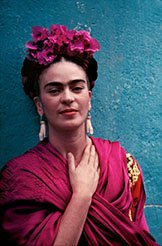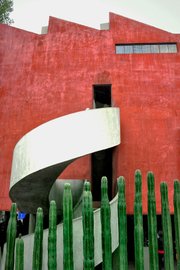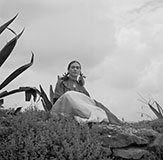One of the most significant artists of the 20th century and an indisputable Mexican, feminist and LGBTQ icon arrived in Springdale this weekend with a brand new exhibition at the Arts Center of the Ozarks. "Frida Kahlo's Garden" is an adaptation of "Frida Kahlo: Art, Garden, Life," which was created for and displayed at the New York Botanical Garden. ACO is the first venue to host the new exhibition on its debut tour, and organizers from both the local side and the exhibition's city of origin are quick to acknowledge the significance of Kahlo's story landing in Springdale.
"I am excited because I feel like this is the first bridge that's going to communicate that this center is here for [everyone]," shares Eve Smith, director of exhibitions and public programs at ACO. "I mean, we have done other inclusive programming, [but] this exhibition, because it's in the galleries, is the first time that the Latinx [and] Hispanic communities [are] going to see themselves as having access to an exhibition space like this. We haven't had a whole lot of programming that is inclusive like that, especially in the galleries."
FAQ
‘Frida Kahlo’s Garden’
WHEN — On display through Jan. 7
WHERE — Arts Center of the Ozarks in Springdale
COST — Free
INFO — 751-5441, acozarks.org
FYI
All Frida, All Day
On Nov. 16, an all-day celebration will be held with folkloric dances, short films, lectures from art historians and Master Gardeners, crafts, tequila tastings and food trucks, as well as an art reception that evening. Visit ACO’s website for a full schedule of events.
“Today, Frida Kahlo is enormously famous worldwide. She has been embraced as an icon by many groups over time — including feminists and individuals of Mexican or Latin American descent. Her self-portraits are immediately recognizable, and they adorn everything from the walls of museums to T-shirts and all kinds of products. Kahlo embraced and embodied her hybrid Mexican identity — her father was German and her mother was Mexican — and in her art, in the collections of pre-Hispanic objects, colonial and folk art, and in the books, plants, and even animals that she gathered in her home in Mexico City, we see her pride in her heritage. It’s a powerful expression of her very personal sense of identity that resonates today.”
— Joanna Groarke,
Director of public engagement and library exhibitions curator at the New York Botanical Garden, where “Frida Kahlo’s Garden” was created
"It's wonderful to see this exhibition traveling to communities throughout the United States, including to parts of the country that haven't previously hosted exhibitions on Kahlo, so that more and more people can learn the history and significance of her work," adds Joanna Groarke, director of public engagement and library exhibitions curator at the New York Botanical Garden.
"Kahlo is truly an icon in Mexico and worldwide -- and for some audiences, this exhibition about her work and her life will represent the first time they can feel like they see themselves in our arts institutions, and visit a fully bilingual exhibition, which is very exciting."
The original exhibition was the first to focus on Kahlo's interest in the botanical world and her engagement with the nature surrounding her home and studio Casa Azul ("Blue House") in Coyoacán, Mexico City. This fresh perspective -- one not centered around her famed husband or the tragedy that filled Kahlo's life -- broadens audiences' understanding of Kahlo as an artist and hopefully allows for deeper connection to her body of work. "Frida Kahlo's Garden" incorporates reproductions of iconic images of the artist and of some of her paintings with examples of native Mexican plants that would have been in Kahlo's garden, as well as replicas of authentic Mexican folk art and a traditional dress reflective of those she often wore.
"We wanted to emphasize that there is a whole rich story about her deep engagement with nature that can be traced not only through her paintings, but also in the evolution of her garden over time, the selection of plants and the changes she and her husband, Diego Rivera, made to the design of the house and the garden," Groarke explains. "This isn't a story that was previously told about Kahlo, and one that we found to be endlessly fascinating and very powerful in what it revealed about her as a person and artist."
The other exciting thing about the exhibition, Smith shares, is the presenters are actually focused on smaller and mid-size organizations for the tour. Through grant opportunities and subsidies, the National Endowment for the Humanities and Mid-America Arts Alliance make an intimate gallery in Springdale, Ark., a leading figure in the national conversation of art and community.
"We hope that we do start to draw some of those people that think that Crystal Bridges [Museum in Bentonville] is the only place to go for art," Smith says. "We went to orientation a couple of weeks ago in Kansas City, all of the host organizations were there, [and] they went through install and deinstall and programming ideas that you would be able to do. Actually, this is going to be our first [fully] bilingual exhibition we've ever hosted in Springdale. It is exciting."
NAN What's Up on 11/11/2018



